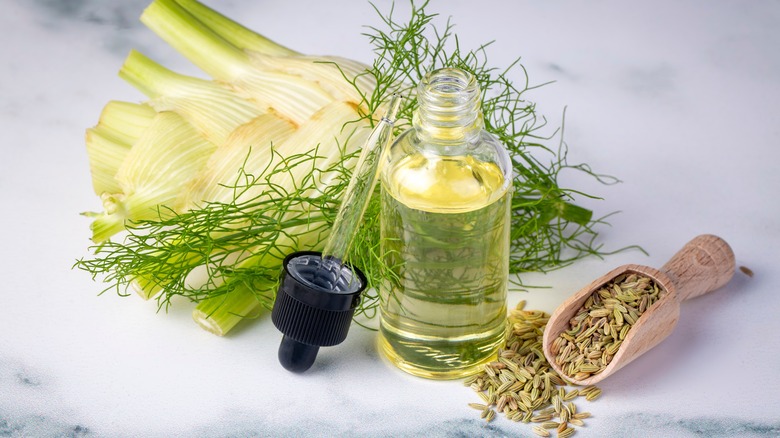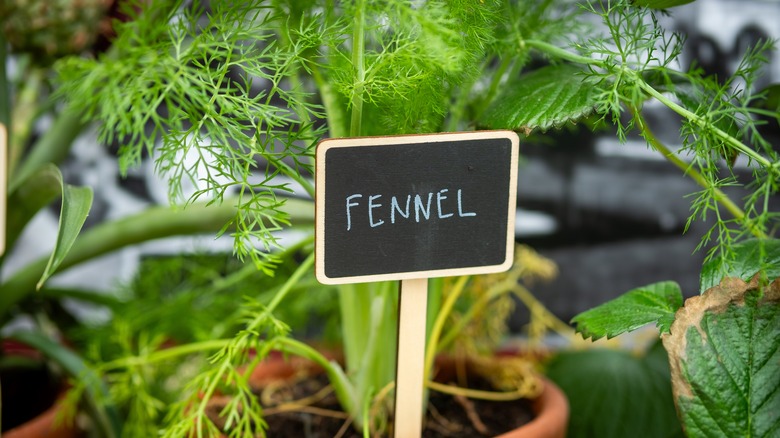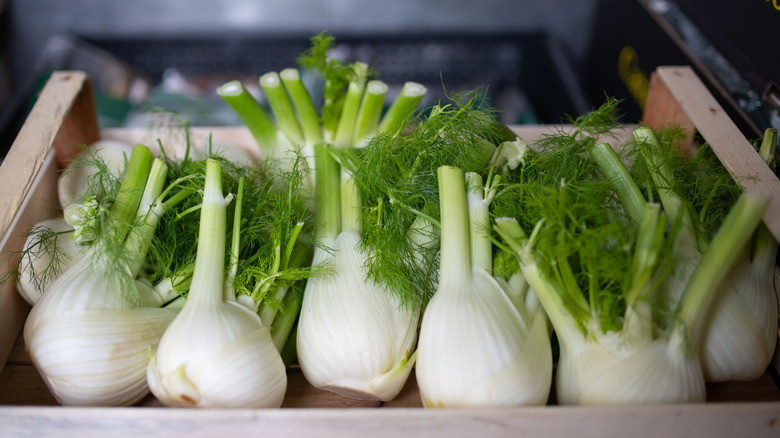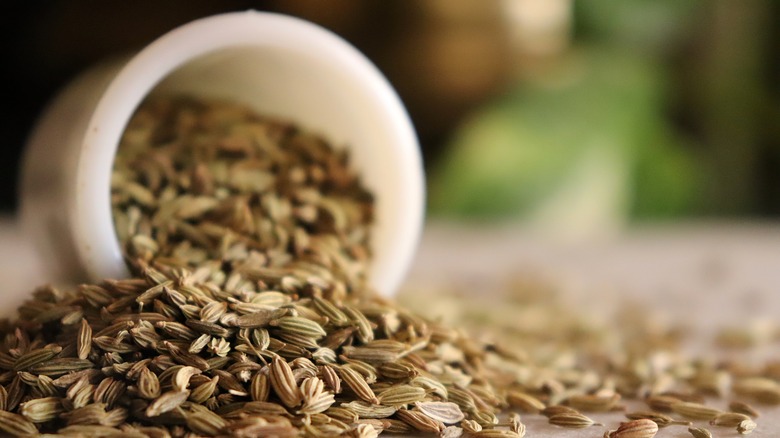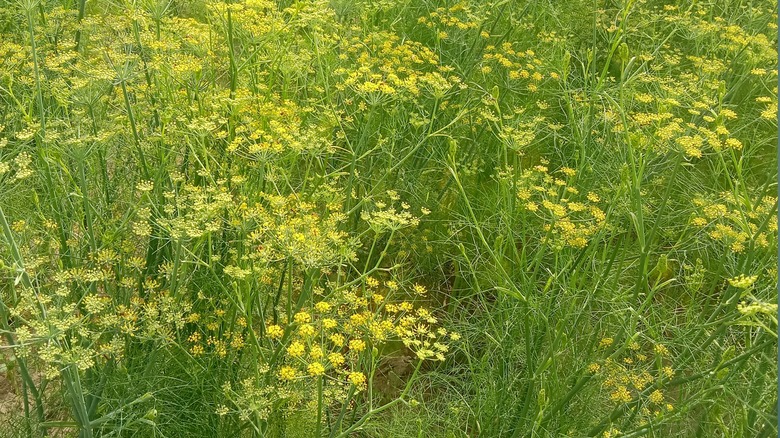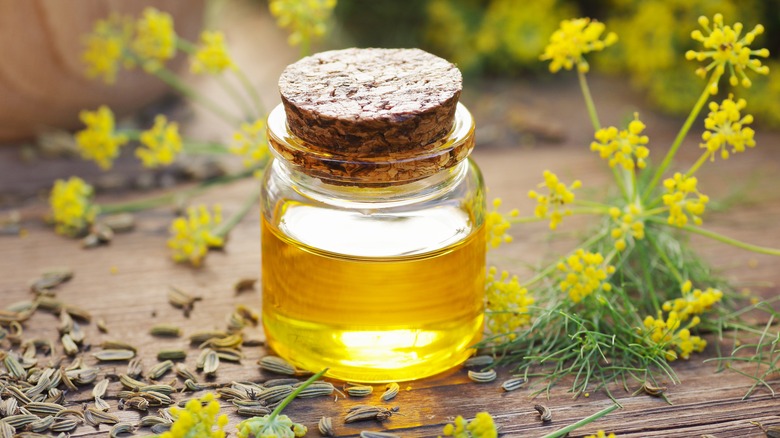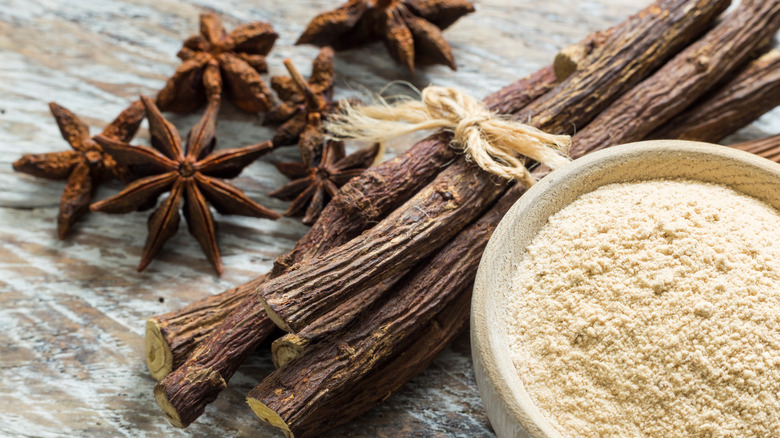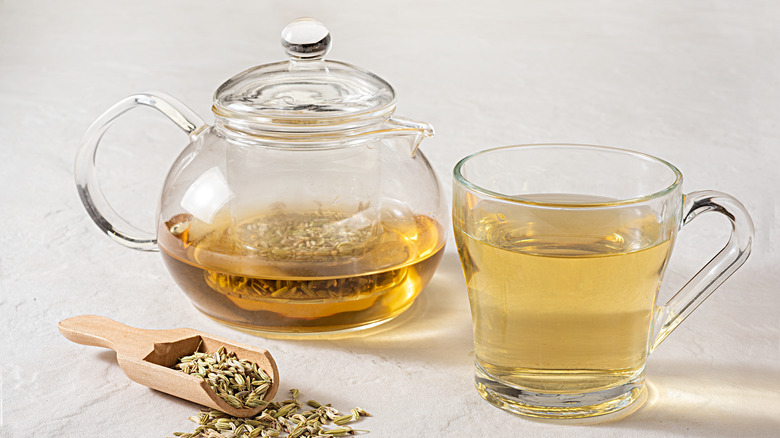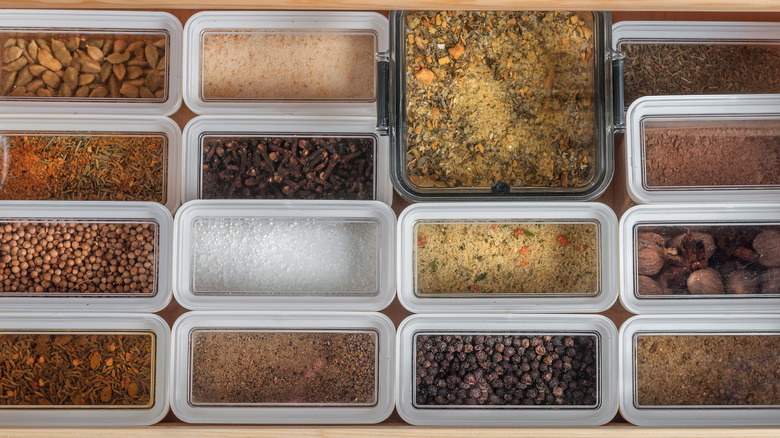The Ultimate Guide To Fennel, From Fronds To Seeds
If you've ever encountered fennel unexpectedly, you may have been surprised by its unique flavor. Visually masquerading as an onion, dill, celery, or anise, fennel may look like a lot of other things, but it is a plant wholly unto itself.
As an ingredient, it pops up in all sorts of places. Fennel is eaten as a vegetable, used as a spice or seasoning, and sprinkled as a garnish; even its pollen and essential oils are harvested for seasoning, flavoring, and scenting. Its distinctive flavor can sometimes fall into the love-it-or-hate-it category, which is why so many top chefs love to play with fennel in their cooking. Be sure to experiment with fennel first to see if it's something you like. You may find that it opens up a world of possibilities in the kitchen. Fennel could be the new secret ingredient that adds an air of sophistication to your culinary endeavors. Best of all, it's a weed that will thrive in your garden!
What is fennel?
Fennel is a plant in the Apiaceae (or carrot) family, though you might not expect these two to be related. Parsley and parsnips are fennel's other relatives. Its leafy green tops is the part of the plant that most resembles a carrot, but fennel isn't a root vegetable. It grows on the ground, above the soil. Native to the Mediterranean, fennel is grown in temperate regions around the world, including the United States.
There are three principal varieties of the fennel plant. Florence fennel, also known as bulb fennel, features a larger pale green or white bulb at the base, which is consumed as a vegetable. Wild, or common fennel, is used for spice, tea, and pollen. It does not have an edible bulb. And sweet fennel is also used mostly as an herb and spice. Fennel is cultivated, but in certain places it is considered an invasive species and much of it also grows wild. You might even find it growing along the side of the road.
Fennel is most notable for its anise or licorice-like flavor. Even rubbing the leaves will pass some of that potent scent onto your fingertips. Its flavor pairs well with both sweet and savory dishes. Nearly every part of the plant can be consumed, from the seeds to the fronds, so let's break down the various components and how they are commonly cooked, used, and consumed today.
Fennel bulb as the main dish
The pale greenish white bulb of the fennel plant, located near the bottom of the stalk just above the roots, is cultivated as a vegetable. It can be eaten raw or cooked. The bulb has layers, similar to an onion, although it does not have any papery skin. It has a crisp texture and powerful anise flavor which mellows considerably when it's roasted. If you're not used to working with fennel, don't worry. Consult this guide to cutting vegetables and start adding some fennel to your repertoire.
If you like that stronger flavor and the crunch of raw vegetables, feel free to add some fresh fennel to your salads. To make it easier to consume, shave the fennel into thin strips. Using a mandoline slicer can help you achieve the thinnest slices. Likewise, roasted fennel, which takes on a much sweeter flavor and caramelized char, can be a wonderful addition to a salad. Raw or roasted fennel pairs beautifully with citrus, like orange or grapefruit. Give this dill and salmon pasta salad with fennel or shaved fennel salad a try at your next dinner party.
You can also add fennel to other savory dishes like baked chicken or fish. Check out these recipes for chicken tray bake with bitter orange and fennel or a whole roasted branzino with fennel. Or make it the star of a dish, like braised fennel wedges, and serve it as a side with your meal.
Fennel as a potent seed
Fennel is one of several plants that is regularly sold and consumed in its seed as well as its flowered form. Like anise, cumin, or cilantro (also known as coriander) fennel seeds can be whole or ground, and are often toasted to bring out their flavor. Fennel seeds are pale green, sometimes tan, have an oblong shape, and a ridged texture. They can be a bit tough to chew, so it's common to break them down with a mortar and pestle or food processor first. Freshly ground spices are often more flavorful, but you can buy fennel already ground.
If you've ever bitten into a sausage and found a seed with a strong flavor you didn't quite recognize, that might've been fennel. Fennel is commonly used in Italian and Indian cooking. It's one of the signature spices in many curry and masala blends and a key component of Chinese five spice powder. You can use fennel seed in marinades for meat or fish, and in pickling to add some aromatic flavor to your veggies. While fennel fronds and pollen are typically used as a garnish for finishing, its seed is more often incorporated into the cooking process to add depth to a dish or beverage.
Using fennel fronds for a special touch
The leafy tops of the fennel plant are also edible. While they bear some resemblance to one another, dill and fennel are very different cannot be used interchangeably. However, they can sometimes go together nicely, and bright green fennel fronds and dill can both be a lovely garnish for a variety of dishes.
Fennel fronds carry the same anise flavor as the bulbs, so keep that in mind when choosing them to garnish your dish or cocktail. The fronds' anise flavor can provide a nice addition and won't overpower most dishes when used in small quantities. When garnishing with fennel, it's important to keep scent as well as taste in mind. Fennel fronds can also be dried for longer shelf life.
Fennel pollen is harvested from the small flowers at the end of the plant that look a lot like the flowers of mustard or rapeseed. Pollen tends to be foraged from wild fennel plants, which is a labor intensive process as each plant yields very little pollen, and thus, makes it an expensive spice to buy. The pollen is dried and has a pale yellow color and almost dusty texture. It carries an anise-like flavor, but with an additional citrusy tang that helps brighten a dish. Sometimes called "fairy dust," you only need a little sprinkle to make a magical impact.
Other uses for fennel
You can find fennel teas made from fennel seeds. This popular herbal tea is tasty, and it is also used to aid sleep, digestion, and to lessen menstrual cramps. Some fennel teas can be incorporated into a blend with other herbs while others are pure fennel. Toasted or candied fennel seeds are also used to freshen breath. It's not uncommon to find fennel in the mukhwas spice blend offered at the end of a meal at an Indian restaurant. Fennel's unique taste makes it a potent option for flavoring liqueurs, candies, and even medicines.
Fennel's flavor and aroma are harnessed in a variety of other products as well. Essential oil is extracted from the seeds of the plant and used to scent products like soaps, lotions, and perfumes. The essential oil can be bottled and sold directly or incorporated into other aromatic blends. Essential oils found in fennel are not just fragrant, but they can also be used as a natural insecticide. The fennel oils are comparably repellent to those of the geranium or citronella plants. Dried fennel stalks can even be added to wood chips for smoking on the barbecue. And fennel flowers have been used as a natural dye.
Differences between fennel, anise and licorice
Fennel and anise come from the same plant family. While they have similar flavors, there are some differences. Fennel is more mild and has a less intense licorice-like flavor than anise. Anise is almost exclusively used for its seeds, not its stalks or fronds. Anise does not have the vegetable bulb that fennel does. Some spice blends will contain both fennel and anise.
The popular spirit aquavit also incorporates both fennel and anise in its flavor profile. If you haven't tried aquavit, it's worth a shot (pun intended). This clear liquor is a high-proof alcohol popular in Scandinavia. You can sip it straight or use it in cocktails when you want something more herbaceous and aromatic than vodka. You can even try swapping aquavit into your next Bloody Mary.
Star anise, on the other hand, comes from an entirely different plant, though it has a similar flavor profile. Often paired with fennel, star anise spice comes from the distinctive star-shaped seed fruit of the Illicium verum tree found in China and Vietnam, rather than the dried seeds of the flowering anise plant. Star anise is more commonly used in Asia, and the famous Chinese five spice powder contains both fennel and star anise along with cloves, cassia, and Szechuan pepper.
Lastly, licorice is actually a root, not a seed. It's probably the most powerful of the three flavors, and it's a famously divisive one. Though often compared, there are significant differences between licorice and anise.
Nutrients and health benefits of fennel
Fennel is a nutritious vegetable and seed that contains many vitamins and minerals such as Vitamin C, calcium, iron, potassium, magnesium, and manganese. It's high in fiber, essential nutrients, and antioxidants thought to be beneficial to humans. Its purported health benefits include its potential to increase heart health and decrease inflammation. Fennel has also been used to support lactation, treat menopausal symptoms, curb appetite, and work as a digestive aid. It's also used as an an anti-fungal.
If you see some wild fennel growing near you, gather some and enjoy its many benefits. Or plant some in your garden for your home apothecary. Fennel has been used as a medicinal herb for centuries. The true extent of its health properties is debated within the scientific community, as some research has been conducted primarily on animals. It is unclear whether fennel actually works to suppress appetite or support weight loss. But some studies show fennel can contribute to anti-inflammatory effects while other studies have shown that fennel can have antibacterial properties.
How to store fennel
Fresh fennel should be stored like any other vegetable. Buying the freshest fennel will ensure the best taste and longer lasting flavor. Look for white bulbs and bright green fronds. If the bulb is spotty or the fronds have started to wilt, it may not be the freshest. Likewise, you'll want to check for that signature licorice-like aroma.
It helps to break fresh fennel down to store it. Cut the stalks and fronds from the bulb and store those either in a jar with some water or in an airtight bag in the fridge to preserve freshness. Keep the bulbs in the fridge and they should last a good week or more. You can also freeze fennel. If you've bought too much or grow some in your garden, fresh fennel can be cut and frozen in an airtight bag or container for up to six months. Simply pop the stalks and fronds into the freezer. Slice and blanch the bulb for best freezing results.
Fennel seeds can be stored along with other spices in a cool, dry, and ideally dark cupboard or pantry. The seeds will start to lose their potent flavor long before they actually go bad, but can last for several years in a sealed container. Fennel pollen is a little more delicate than fennel seed and will start to lose its fragrant potency sooner. However, the pollen will still be safe to consume after it has begun to fade.
